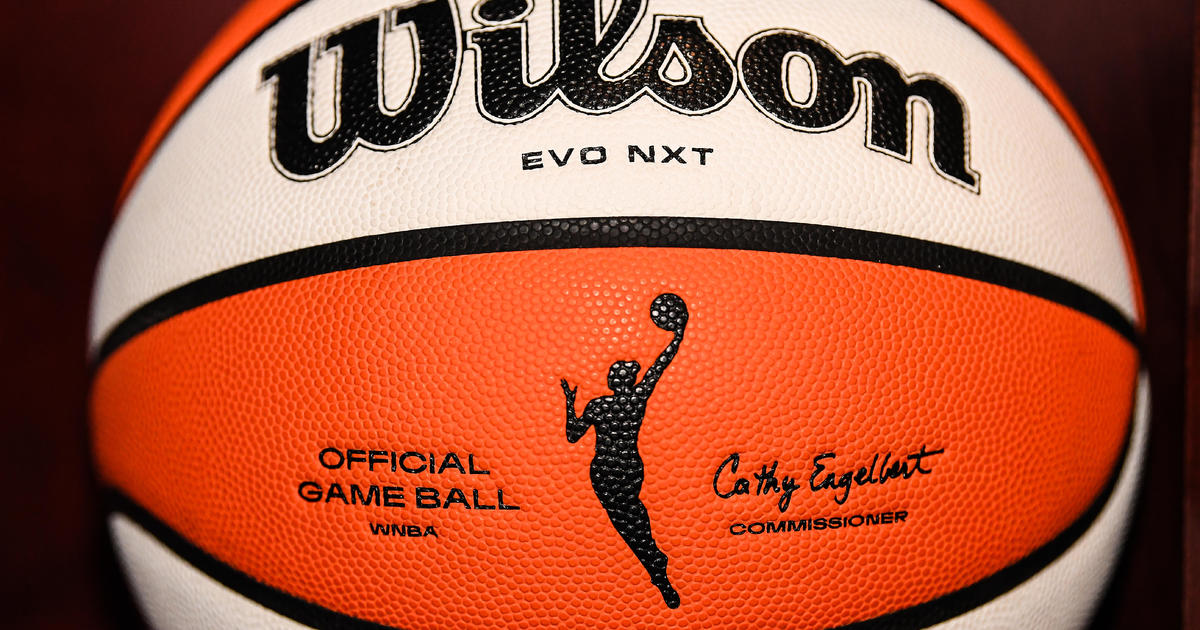Hoge: A Newfound Respect For Curling
By Adam Hoge-
NORTHBROOK, Ill. (CBS) — Two somewhat athletic men, in their late 20s, standing with their hands on their knees, completely out of breath.
And that's after just one trip down the ice, broom in hand, vigorously sweeping to get the stone over the hog line.
"OK, only seven more stones to go, then nine more ends," veteran curler Colin Rittgers said. "Oh, and you have another match later today."
All right, so curling doesn't quite require the physical conditioning to play football, hockey or basketball, but this isn't shuffleboard on ice.
And don't ever suggest it is to actual curlers.
Adam Hoge Talks Curling
670 The Score's Connor McKnight and I learned that firsthand Wednesday at the Chicago Curling Club in Northbrook, where we both received an appreciation for the sport that resurfaces on network television every four years at the Winter Olympics.
PHOTOS: Hoge And McKnight Try Curling
"It's sort of like golf," Joni Cotton, an alternate for the 2002 Olympic women's curling team, said, referring to the precise nature of the shots.
Great. That means I'm about to get addicted to another sport that will whack me over the head endlessly.
Good thing there's a bar 30 feet from the ice.
What Is This Sport?
If you're like me, you might be staying up late during the Olympics watching curling live on the Internet. You might even record it overnight and watch it the next day.
Or, if you're a more normal person, you probably wait for the tape delayed broadcasts that are shown while the sun is up.
Either way, you probably have a few questions. Why are they wearing shoes on ice? Why are they carrying brooms? Why are they always yelling, "Hard. Hard. Hard!"?
Here are some of the basics:
- The stones weigh 42 pounds and have a weighted handle that allows the stone to curl. How hard the stone is thrown is determined by how hard the curler pushes off the "hack," located at the end of the ice sheet.
- The ice itself is "pebbled," creating a somewhat rough surface on the ice. You might think this is designed to slow down the stone, but it actually does the opposite. The pebbled surface creates less surface area for the stone to travel on, reducing the friction.
- The brooms aren't really brooms. The bottom consists of fabric and the sweeping action heats up the ice, which prevents the stone from slowing down and reduces curling. This is how the stone is steered down the ice once it is thrown.
- How do curlers glide down the ice so quickly without falling? Because of the shoes. One shoe is the "slider shoe," worn on the off foot, which has a Teflon sole. The other is the "hack foot shoe," worn on the foot you push off the hack with, which has a rubber sole, designed to increase grip on the ice. Essentially, you slide on the off foot and keep control with the other.
- The strategies are complicated, but the scoring is not. The stones are thrown into the house, consisting of three concentric rings. A team receives a point for each stone it has closer to the middle of the house -- the button -- than its opponent's closest stone. Only one team can score in an end. For example, if Team A has two stones in the middle, but the next closest stone is Team B's, then two points are awarded to Team A.
- There are 10 ends in a match. The team with the most points at the conclusion of the 10th end wins.
The Club
Curling's origins go back to 16th-century Scotland, so you can understand the golf comparisons. It's a winter sport made for golfers, so the Chicago Curling Club comes complete with a bar and lounge with a big screen television showing, of course, curling.
Our instructors for the day were Rittgers and Stephanie Martin, two club members with impressive curling credentials.
Rittgers was drawn to curling after watching the sport explode in popularity during the 2006 Torino Olympics. Since then, he's played in the U.S. Club Nationals in 2012 and U.S. Mixed Doubles Nationals in 2011 and 2013. He's scheduled to participate in Mixed Nationals again this March.
Martin, meanwhile, won the U.S. Senior Nationals in 2012 and finished fifth at Worlds in Copenhagen, Denmark, representing the United States.
"It was an amazing experience and one I will remember forever," she said. "It was an honor to have USA on my back."
The curling world is a small one, especially in the United States. If you participate in bonspiels (curling competitions), you are bound to run into a U.S. Olympian.
Rittgers has played against both Debbie McCormick and Ann Swisshelm, two members of the U.S. women's Olympic team in Sochi. He was also in a bonspiel that included John Schuster, the "skip" of the U.S. men's Olympic team, but Riggers didn't get the chance to play against him.
"I'm guessing you won't be skiing with Bode Miller or snowboarding with Shaun White anytime soon, but in curling you can play the best and not get hurt -- hopefully," Rittgers said.
Swisshelm's home club is Exmoor Country Club, located in Highland Park, while McCormick's is Pardeeville Curling Club in Pardeeville, Wis. Both have played and practiced at Chicago Curling Club in their careers.
Time To Try It
Stepping on the ice, the first goal is not to fall. But actually, the easiest part of curling was getting used to moving around on the ice with the slider and hack-foot shoes.
Rittgers and Martin got us started with some basic drills. First, with a stone in both hands, we practiced pushing off the hack.
"I can already tell this is a lot harder than it looks," I said after one rep, in which I would have failed a sobriety test trying to stay in a straight line.
After that, we worked on curling the rock and, to my surprise, learned that you put the same rotation on the stone each throw. It's the "weight" (how hard you throw it) and sweeping that determines how much the stone actually curls.
Then came the moment of truth, when Connor and I tried to land some actual shots in the house. They give you a stabilizer when you are first learning, so you don't fall on your face.
Of course, we still had no idea what we were doing, so my first shot went right through the house and luckily not through the wall at the end of the ice.
"Good take-out shot," Martin said.
My second shot was better, but still didn't require any sweeping, at least until the very end when Martin crushed my dreams and swept my stone out of the back of the house.
I overcompensated a lot on the third shot, requiring Rittgers and Jessica Thomson, the club's communication director, to sweep hard just to get the stone over the hog line. If it hadn't gone over the hog line, the stone would have been thrown out.
"This is when you thank your sweepers," Martin said.
Connor, meanwhile, realized right away when he pushed off that his stone wasn't going to get to the house, so he cheated and gave it an extra push with his hand before letting go. It sailed right through.
Then, a minor miracle occurred, as his second shot landed right on the button -- with the help of Rittgers' and Thomson's sweeping, of course.
Finally, it was our turn to sweep. And I quickly realized why you should always thank your sweepers.
I wonder how hard the audience in the lounge was laughing.
First, I had my broom upside down. Then, I had Connor spending more time sweeping my broom than the ice in front of him.
I also knocked the stone at least twice, which I still don't understand how the professionals avoid doing.
About halfway down the sheet, I thought I might have a heart attack.
I'm pretty sure Connor did.
It made me think back to my baseball days, where I was the slap singles hitter whose greatest strength was probably sprinting 90 feet to beat out a throw.
This wasn't sprinting, but it was shuffling on ice while strenuously sweeping -- for 146 feet.
And that's when Rittgers hit us with the reality of doing that eight times per end, 10 ends per match, with multiple matches per day.
That's what the Olympic curlers are doing in Sochi, playing a match every day -- with doubleheaders every two days -- making me feel really bad about how out of shape I am.
But Joni Cotton was right, curling is a lot like golf. Our time was up, but I didn't want to stop, despite knowing the anxiety the game was sure to cause me if I kept going.
And that's why the Chicago Curling Club has roughly 350 members (membership information can be found here), hosting curlers of almost any age. Wednesday, there was youth curling going on, while an 85-year-old man at the club said he'd been curling for 35 years.
"We've had 75 new members sign up this year," Thomson said. "Membership often receives a bump each time the winter Olympics are held."
I can see why. Just this week, I've watched hours and hours of curling, read countless stories on the sport and even joined a Facebook group dedicated to the Norwegian curling team's pants.
Something tells me I'll be back on the ice soon. And next time I'll bring better pants.
Adam Hoge covers the Bears for CBSChicago.com and is a frequent contributor to 670 The Score. Follow him on Twitter at @AdamHoge.



